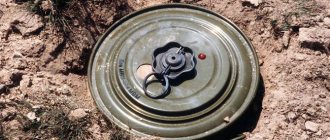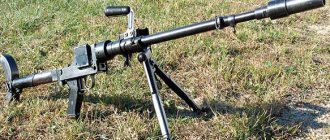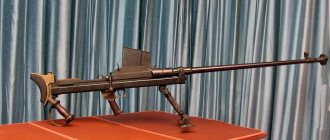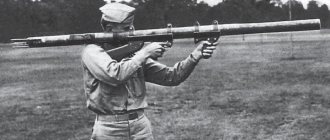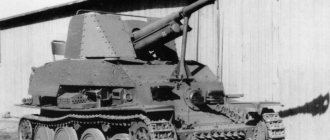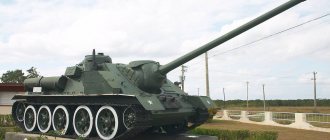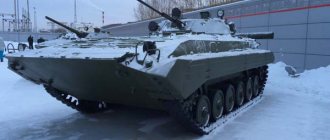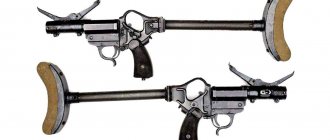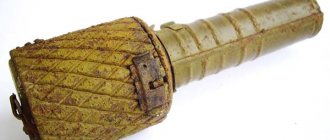Modern Russian anti-tank grenade launchers at a weapons exhibition During the First World War, advancing infantry with small arms could be stopped and pinned to the ground relatively easily by a single machine gun firing from a minimally fortified position. Armored cars had the same paralyzing effect - rifles were powerless against them. Soldiers of modern armies in such situations will no longer wait for artillery to approach, because they have grenade launchers - a universal and powerful weapon that greatly increases the capabilities of troops both on the offensive and in defense. This type of weapon is very “many-faced” - grenade launchers differ in their principle of operation, purpose, and dimensions. They have one thing in common: the target is hit not by the kinetic energy of the projectile, but by the products of the explosion - excess pressure, high temperature or fragments.
RPG LAW M72 - American anti-tank grenade launcher
In the early seventies, the United States began developing a new close-combat anti-tank weapon that could be controlled by a single soldier. They wanted to not only replace the outdated Bazooka grenade launchers, but also use them to protect buildings not covered by anti-tank defense guided missiles. The weapon was developed by the American company Hesse Eastern Co., and in 1969 it was put into service with the American army. Grenade launchers of this type are included in the equipment of the armies of Australia, Belgium, Denmark, Great Britain, Israel, Canada, the Netherlands and Austria. In Norway, the American disposable RPG LAW M72 A2 and M72 A3 are produced under license.
Rocket in a suitcase
What the bloc sent: how NATO is transforming the Ukrainian army
Will the alliance's help change the situation in Donbass?
Javelin is one of the most effective anti-tank systems in the world. The unit is placed in a carbon suitcase and transported behind the fighter’s back. You can deploy the weapon in a couple of minutes, another minute is needed to prepare and strike the target.
The main disadvantage is the high cost. One shot costs $80,000, often much more than the cost of the weapons it destroys.
For the first time, Ukraine requested an anti-tank system from the United States after the defeats in Donbass. In Kyiv, the armored vehicles of the militias were considered a serious problem, they stated that the tanks of the DPR and LPR participated in the creation of the Ilovaisk and Debaltsevo cauldrons, and destroyed a number of checkpoints of the Ukrainian Armed Forces.
Pack of rockets
"Javelin" - American man-portable anti-tank missile system
Photo: Global Look Press/US Army
Base shift: Kyiv asks to place a US military facility in Ukraine
Square is negotiating with the American side, but Washington is in no hurry to make official promises
Former Ukrainian President Petro Poroshenko proposed purchasing the complexes in 2015. It is interesting that the head of the Ukrainian state then demanded 1,240 missile systems at once. For some reason, Poroshenko decided that the United States should reimburse Kyiv for the 1,240 nuclear warheads it abandoned in 1994.
The United States hesitated for a long time to make such supplies. The Barack Obama administration transferred dry rations, first aid kits, and uniforms to Kyiv, but kept lethal weapons with itself. Washington explained that they did not want to aggravate the situation. Perhaps they were also afraid that anti-tank systems would fall into the hands of DPR and LPR soldiers.
RPG LAW M72 - video
Modifications of the first model are still produced in the USA. It is not known for certain how the improved versions differ from the main one. There is only information that grenade launchers of models 72 and 72 A1 (previously produced) penetrate armored steel with a thickness of 250 mm to 275 mm, and new versions - 305 mm. Apparently a more powerful shaped charge grenade is used.
Single-use LAW M72 hand grenade launchers (LAW - Light Antitank Weapon) are supplied by the manufacturer complete with a grenade in the barrel and a charge. To bring the weapon into combat readiness, it is necessary to pull the outer pipe 280 mm back. The outer tube is made of fiberglass, the inner tube is made of aluminum alloy.
The barrel contains the trigger and impact mechanisms, a sighting device and a carrying handle. The sighting device consists of a frame sight installed in 25 m increments in the range from 50 to 350 m, as well as a folding diopter. Using the scale of the frame sight, the lead is determined when firing at targets moving at speeds up to 24 km/h. Moving targets can be hit at a distance of up to 150 m, stationary ones - up to 300 m. According to the manufacturer, the damaging effect of a shaped charge is possible at a distance of up to 1000 m. The grenade has a reactive powder charge, a stabilizer consisting of six elements, and an impact fuse .
American infantry anti-tank weapons. Part 1
Shortly before the outbreak of World War II, the American army did not have any specialized anti-tank weapons at all. The fight against enemy tanks was entrusted to field artillery, which for the most part was very outdated.
To combat armored vehicles, in addition to field guns, it was planned to use the old 37-mm M1916 assault infantry guns, originally created for artillery support of advancing infantry, destruction of firing points and destruction of light fortifications. This gun is an American version of the French 37mm Puteaux trench gun, created during World War I to combat machine gun nests and field fortifications. The gun weighed a little more than 100 kg and could be carried in separate packs: the swinging part - 40 kg, the machine - 40 kg, other parts - 28 kg.
Effective fire at the embrasures of bunkers was ensured at a distance of up to 1200 m. The combat rate of fire was up to 15 rounds/min. A solid, blunt-headed armor-piercing projectile weighing 560 g left the barrel with an initial speed of 400 m/s, and at a short range could penetrate more than 50 cm of compacted soil buried between one-inch wooden boards.
Infantry 37-mm gun M1916
The characteristics of an armor-piercing projectile on steel armor plate are unknown, it can be assumed that at a distance of 200 m it was “too tough” with 15 mm armor. But in any case, in the 30s of the last century, the 37-mm infantry gun was a hopelessly outdated model, unable to withstand promising tanks
Until 1940, anti-tank companies of infantry regiments were armed only with large-caliber 12.7-mm Browning M2НВ machine guns. An infantry modification of the air-cooled machine gun with a tripod mounting was adopted for service in 1933. Taking into account the fact that in the 1930s light tanks predominated in the armed forces of most states, the Browning heavy machine gun could be considered a fairly effective weapon.
The characteristics of the .50 BMG ammunition (12.7x99 mm) made it possible to penetrate the frontal armor of light tanks at distances of 20-300 m. Thus, the M1 bullet weighing 48.6 g with a core made of hardened carbon steel, adopted for service in 1931, had an initial speed of 810 m/s, and at a normal distance of 250 m could penetrate 20 mm armor plate. When firing from 100 m, armor penetration increased to 25 mm. It is worth recalling that the thickness of the frontal armor of the “export” British light tank Vickers Mk E (also known as the “Vickers six-ton”) and the Soviet T-26 and Polish 7TP created on its basis did not exceed 16 mm.
12.7 mm Browning M2НВ machine gun in a firing position
The Browning heavy machine gun turned out to be a very successful and versatile means of combating light armored vehicles; it could also be successfully used against enemy personnel at long distances, suppress firing points and be used in military air defense. However, with a machine gun body weight of 38.2 kg and a machine weighing more than 20 kg, the weapon, even when disassembled, was quite cumbersome to carry over considerable distances.
At the end of the 30s, an attempt was made to create a battalion and company level light anti-tank weapon based on the Browning M2НВ machine gun. In this way, the United States tried to eliminate the main drawback of the machine gun - its excessive weight for an infantry weapon. The anti-tank rifle inherited the principle of automatic operation due to recoil with a short stroke of the weapon's barrel. The barrel bore was locked with a wedge that moved in a vertical plane depending on the position of the weapon barrel. To reduce recoil, the anti-tank rifle received a spring-loaded butt. The fire was carried out using a bipod. The main part of the weapon parts was taken from the machine gun without changes, which in turn had a negative impact on the weight.
A pistol-type handle was used to control the fire; fire could only be fired in single shots. The weapon was fed using a standard machine gun belt. Aiming was done through a diopter sight. The weight without ammunition was 34 kg - that is, a 12.7 mm anti-tank semi-automatic rifle weighed about the same as an M2НВ machine gun without a machine gun. In essence, it was a large-caliber machine gun on a bipod, capable of firing only single shots. For testing, several prototypes were created, differing in design and barrel length, all of them turned out to be very bulky and heavy. Although the reliability of the automation did not cause any particular complaints, the army command did not consider it advisable to accept this model for service.
The weight and dimensions of the weapon made it poorly mobile, and its armor penetration characteristics made it possible to fight only light tanks. In addition, the weapon turned out to be quite expensive; its cost in mass production would have been no less than $600. In 1940, the American army purchased M1 Garand rifles at a price of $85 per unit. Experiments with the British 13.97 mm Boys anti-tank gun did not satisfy the American military. Although several hundred anti-tank missiles entered the anti-tank companies of the Marine Corps, weapons that penetrated an inch armor plate at a distance of 100 m could no longer be considered a reliable means of combating tanks that had anti-ballistic armor.
The American infantry needed a simple, inexpensive and mass-produced anti-tank weapon, superior in range to hand-thrown grenades. Shortly before the start of World War II, the M7 rifle fragmentation grenade was adopted. The grenade was attached to the rifle barrel using a special 22-mm adapter, also designated M7. The shape of the grenade resembled a mortar shell and was fired with a blank cartridge. In 1942, production of the M9 anti-tank rifle grenade with a cumulative warhead began.
Model of the M9 rifle cumulative grenade next to the M7 grenade launcher adapter.
The grenade with a body diameter of 51 mm and a mass of 590 g contained 119 g of pentolite. However, soon after the start of deliveries to the troops, it became clear that the head fuse of the grenade is not always reliable and safe, and also does not provide an optimal layout relative to the shaped charge. In this regard, the grenade was modernized and equipped with a bottom fuse and a ballistic cap. After which it received the designation M9A1.
When fired from the M1 Garand and Springfield M1903 rifles, the grenade received an initial speed of 55 m/s and, when launched at an angle of 45 °, flew 250 m. However, the effective firing range against armored vehicles did not exceed 70 m. When hitting a target, the M9A1 could penetrate 50 meters normally mm armor, which was not enough to reliably defeat medium German tanks. Nevertheless, until August 1945, more than 2.5 million M9 and M9A1 grenades were fired and they were used very successfully against lightly armored Japanese tanks.
Initially, the US Army was supposed to have one grenade launcher in the infantry squad, but in 1944 this number increased to 2-3 shooters with rifle grenade launchers. In the USMC, before landing on the Pacific islands, approximately 25% of the shooters were armed with rifles with muzzle attachments. After the end of the war, together with American M1 Garand rifles, M7 grenade launchers with M9A1 grenades were supplied to US allies. During the Korean and Southeast Asian Wars, these weapons were captured in significant quantities by North Korean troops, Chinese People's Volunteers, and Vietnamese guerrillas. M9A1 grenades turned out to be ineffective against tanks, but they hit armored personnel carriers, armored reconnaissance vehicles and trucks with confidence.
Calculations have shown that in order for a cumulative grenade to be able to penetrate the frontal armor of a medium tank, its caliber must be increased to 57-60 mm, and at least 200 g of powerful explosives must be used. As a result, a 60-mm M10 rifle grenade weighing about 1500 g was born, the warhead of which contained 220 g of pentolite behind the cumulative funnel. When hit at right angles, the shaped charge could penetrate 90 mm of armor.
However, it soon became clear that the target firing range using a standard 22 mm choke tube and a blank cartridge does not guarantee the personal safety of the shooter after a close warhead rupture and is not much greater than the throwing range by hand. After this, they tried to turn the grenade from a rifle grenade into a “machine gun”. For this purpose, we developed a special attachment and a reinforced blank cartridge for the 12.7 mm M2NV machine gun. However, excessive recoil had a negative impact on the reliability of the weapon, and the firing range and accuracy still left much to be desired. In addition, as already mentioned, a large-caliber machine gun was a fairly heavy and expensive weapon, and it turned out to be impractical to use it to shoot anti-tank grenades with an effective range of less than 100 m. In this regard, it was decided to develop a special device that would allow the warhead of the M10 cumulative grenade to be safely delivered to the target.
At the end of the 30s, the United States was already experimenting with weapons based on the recoilless principle. But since projectiles with a low initial flight speed and a high-explosive warhead were used, it was not possible to achieve acceptable armor penetration. In 1942, Captain Leslie A. Skinner and Lieutenant Edward G. Yule were able to adapt a jet engine containing 75 g of pyroxylin gunpowder to the cumulative warhead of the M10 grenade and create a launcher. The new weapon was officially named 2.36-inch Anti-Tank Rocket launcher M1 and unofficially called Bazooka, in honor of the giant trombone of comedian and jazz musician Bob Burns.
The M1 anti-tank rocket launcher consisted of a 1370 mm long smooth-walled steel pipe open on both sides, an electric ignition device, a safety box with a contact rod, sighting devices and a shoulder rest. The anti-tank grenade's jet engine was started using an electric fuse, the electrical impulse to which came from two dry batteries. The electric trigger mechanism structurally consisted of an indicator light, electrical wiring and a contact contactor, which was triggered by pressing the trigger, as well as an electrical circuit breaker, which served as a fuse.
At the rear end of the pipe there was a spring-loaded latch that held the grenade in the barrel and served as a short circuit to ground. The wire ring protected the pipe from foreign objects and made loading the grenade easier. To hold the Bazooka, there was a pistol grip under the middle part of the barrel and an additional handle in the lower front part of the barrel.
An American soldier with a 60-mm M1 anti-tank grenade launcher.
A rocket-propelled grenade, designated M6, was intended for firing from the Bazooka. Its length was 540 mm, and its weight was 1550 g. The first version of the grenade had a streamlined head and a feather stabilizer. At a temperature of + 20°C, the jet engine accelerated the grenade to 83 m/s. The sighting devices were designed for a range of 183 m. For training purposes, an M7A1 rocket-propelled grenade with an inert warhead was used. In order for the mass and ballistics of the training grenade to correspond to the combat version, a metal rod was screwed into the fuse point. The training grenade was completely painted black.
M6 rocket-propelled grenade
One soldier fired from a grenade launcher weighing 8 kg, but loading the weapon was quite difficult. To do this, the safety box breaker lever was moved to the “SAFE” position.
The loader, having pressed the spring-loaded latch with one hand, inserted the grenade into the pipe with the other hand and removed the safety pin, after which he released the latch, which was supposed to jump behind the cutout on the stabilizer. Before firing, the release lever was raised to the "FIRE" position, after which the contact rod touched the contact ring on the grenade.
After completing the loading process of the Bazooka, the second member of the crew had to leave the danger zone that formed behind the weapon when fired, and also make sure that there were no other military personnel, flammable objects or ammunition there. The danger zone behind the grenade launcher was 25 m. Due to the fact that incomplete combustion of the powder charge in the barrel often occurred, the crew was forced to use gloves and gas masks without filters to avoid burns. A well-trained and well-coordinated crew could fire 10 aimed shots per minute.
If necessary, loading the grenade launcher and firing could be carried out by one soldier, but the rate of fire was reduced by about three times. A two-man Bazooka crew using special M6 bags or M1 mortar vests could carry nine 60-mm rocket-propelled grenades. Usually the shooter carried 2-3, and the loader 6 grenade launcher shots.
The Bazooka's baptism of fire took place during Operation Torch, the landing in North Africa that began on November 8, 1942. However, grenade launchers received recognition later - in the spring of 1943. In Tunisia, grenade launchers confidently hit German and Italian medium tanks. At a range of up to 110 m, the shooting accuracy turned out to be satisfactory, and a well-trained grenade launcher, in the absence of a strong side wind, was very likely to hit the frontal projection of the tank.
The American infantry received a truly effective and inexpensive anti-tank weapon, although not without significant drawbacks. The electrical ignition system for the reactive charge caused the most criticism. Dry batteries had the ability to discharge at the most inopportune moment, and in wet weather the discharge rate increased several times. The grenade launcher crews complained about the inconvenience of carrying the long “pipe.”
At first, due to the imperfection of the reactive charge, when firing grenades of the early series in hot weather, the barrel ruptured, and in cold weather, the gunpowder did not have time to burn completely in the table, and the jet stream affected the crew. That is, the rate of fuel combustion in a jet engine depended too much on the ambient temperature. The stabilizers of the M6 rocket-propelled grenade were easily deformed, which negatively affected the shooting accuracy. In addition, it was revealed that the streamlined shape of the grenade head increased the tendency to ricochet, which, combined with the not very reliable operation of the inertial fuse, reduced the likelihood of hitting the target.
But still, the advantages of the new anti-tank weapon outweighed the disadvantages. American industry produced 112,790 grenade launchers of the first modification, which was facilitated by their low cost and simple design. By the end of 1943, the infantry company had three Bazookas, located in the control section of the heavy weapons platoon. Each infantry squad was required to have two riflemen trained in the use of grenade launchers. The anti-tank grenade launchers themselves were issued from the heavy weapons platoon if necessary. Another seven Bazookas were in the heavy weapons company of the infantry battalion and eight in the headquarters company. Thus, the personnel of the infantry battalion could use 24 grenade launchers against enemy tanks. A significant number of anti-tank rocket launchers were also available in other units - for example, each artillery division of 105 mm or 155 mm howitzers, according to the states of March 1943, received 40 Bazookas. By the spring of 1944, American units in Europe were sufficiently equipped with anti-tank grenade launchers, which of course had an impact on the course of hostilities.
In July 1943, a modernized version of the M1A1 grenade launcher and an improved M6A1 rocket-propelled grenade were adopted. Thanks to the modified formulation of the solid propellant charge, it was possible to achieve a more stable combustion rate. Also, to improve reliability, the design of the electrical wiring was changed. While maintaining the same length, the weight of the M1A1 grenade launcher was reduced by 1.2 kg. To prevent ruptures, part of the barrel in the area from the ring on the rear section of the pipe to the middle of the shoulder stop was reinforced with a winding of steel wire. To protect the shooter from the effects of powder gases, a protective screen made of fine-mesh metal mesh, twice the diameter of the barrel, was installed on the front end of the barrel.
Mass deliveries of M1A1 grenade launchers to the American army began at the time of the Normandy landings. In total, 59,932 grenade launchers of the M1A1 modification were produced. Back in 1943, during battles in Italy, it became clear that the Bazooka was unable to penetrate the frontal armor of heavy German tanks. In addition, the Germans began to actively install anti-cumulative shields on later modifications of the Pz.Kpfw.IV medium tanks and self-propelled guns produced on their basis. In this regard, the military accelerated the development of a new modification of the grenade launcher and more effective cumulative ammunition.
In the summer of 1944, the first copies of the M9 grenade launcher arrived at combat units operating in Europe. Compared to the M1 and M1A1 modifications, the combat and operational properties of the weapon were significantly improved. In the model, officially called the 2.36-inch Rocket launcher M9, they tried to eliminate the main shortcomings of previous models.
The new grenade launcher was partially made of light alloy, which made it possible to lengthen the barrel to 1550 mm without increasing weight. Unreliable and overly sensitive to climatic factors, the batteries were replaced with a more reliable induction generator mounted in the pistol grip. A convenient safety mechanism switch has appeared on the left side of the handle. The wooden shoulder rest was replaced with a lightweight aluminum frame-type rest, and a bell appeared instead of a protective screen. The abandonment of the protective screen was due to the fact that the powder charge of the jet engine was now completely burned out in the elongated barrel. Instead of simple mechanical sighting devices, an optical sight with a scale marked at a distance from 46 to 540 m was placed on the folding base to the left of the barrel.
Optical sight of the M9 grenade launcher
However, the effective firing range of the grenade launcher remained the same as in earlier modifications, and at a maximum range of 540 m it was possible to fire only at large area targets.
Shooter with M9 grenade launcher
Especially for airborne units, in June 1944, a collapsible modification of the M9A1 with a reinforced rear part of the pipe was created. Since the reinforcement was made by winding it with steel wire, the weight of the weapon was 7.2 kg. In total, the armed forces received 26,087 M9 grenade launchers and 27,781 M9A1.
Grenade launchers with M1A1 and M9 disassembled
Simultaneously with the improvement of the grenade launcher, the ammunition was also improved. The M6A1 and M6A2 rocket-propelled grenades had a modified electric igniter design and a more durable tail unit. At the end of 1944, production of the radically improved M6AZ cumulative grenade began. The new grenade was very different in appearance from earlier models.
M6AZ rocket-propelled grenade
To reduce the likelihood of a ricochet, the head part received an oval shape. And the feather stabilizer, which caused a lot of criticism, was replaced with a cylindrical one that was more durable and convenient to load. The M6A3 warhead contained 230 g of pentolite, and the rocket engine was loaded with 65 g of gunpowder. Thanks to the increased explosive charge and the replacement of the steel lining of the cumulative recess with copper, armor penetration was increased to 100 mm. At the same time, the length of the grenade was 475 mm, and the weight was 1530 g. After the combustion of the powder charge, the grenade left the barrel at a speed of 85 m/s. The effective range remains the same - up to 110 m.
Since “Bazookas” were very often used by troops against manpower, long-term firing points and in street battles, it was necessary to expand the range of ammunition. For the M1A1, M9 and M9A1 grenade launchers, fragmentation and incendiary grenades filled with white phosphorus were used, as well as smoke grenades with charges of red, yellow, purple and green - intended for target designation of aviation and artillery.
In the fall of 1944, American paratroopers fighting in the southern regions of France, having tested the M9A1 grenade launchers in combat, noted increased combat effectiveness and ease of use. In the first months of 1945, the M9 and M9A1 Bazookas practically replaced the M1 and M1A1 from linear infantry and airborne units. At the same time, in the control, supply and maintenance units, the M1 and M1A1 grenade launchers were in service until the end of the war.
In May 1945, production began of the last serial modification of the 60-mm Bazooka, the M18. Limited to only 500 units, this model uses a stronger aluminum alloy for the rear barrel. This reduced the weight of the grenade launcher by more than two kilograms and increased corrosion resistance in humid tropical climates. Externally, the M18 differed from the M9 by a conical bell instead of a wire ring, and the optical sight received a rubber eyecup and a protective cover.
It is worth mentioning the combat use of the Bazooka. After the Allied landings in Normandy, the brunt of the fight against German tanks fell on American and British fighter-bombers. Given the Allied air supremacy, the few German tanks did not always even have time to reach the front line. If German armored vehicles did appear on the battlefield, they were opposed by numerous M10 Wolverine tank destroyers armed with a 90-mm gun, as well as 57 and 76-mm towed M1 and M5 anti-tank guns. Therefore, German tanks rarely reached the positions of American infantry units. But taking into account the high saturation of the American troops with Bazookas (the infantry division in the summer of 1944 had at least 557 anti-tank grenade launchers), cases of combat use against tanks, of course, took place.
60-mm grenade launchers have fully justified themselves. After the appearance of the M9 and M9A1 models with an induction electric launch system, the weapon became quite reliable. But even after the introduction of M6A3 high-efficiency grenades, heavy German Tiger and Panther tanks could only be hit on the side. At the same time, the Bazooka successfully penetrated the frontal 80 mm armor of the Four, which was the most popular German tank until the end of the war.
In the Pacific theater of operations, Bazooka missiles easily hit any Japanese tanks. The matter was also made easier by the fact that there were few tanks in the units of the Imperial Army defending the Pacific islands and they were used separately. In addition, dense vegetation made it possible for grenade launchers to camouflage themselves well and fire from a dagger-like distance. However, in battles with the Japanese, rocket-propelled grenade launchers were most often used not against armored vehicles, but to destroy enemy firing points and manpower. Several hundred captured American grenade launchers were used by the Germans. It is believed that after becoming familiar with the captured Bazookas, the Offenrohr and Panzerschreck rocket launchers were created in Germany. A copy of the M1A1 grenade launcher was produced in Hungary under the designation M.44.
An American soldier with M1A1 grenade launchers and a German Panzerschreck.
With almost the same length, a significant difference in caliber is noticeable. In Japan, in mid-1944, they adopted their analogue, known as “Type 4”. Unlike the Bazooka, the 70-mm Japanese grenade launcher used a mechanical trigger mechanism, and the grenade was stabilized on its trajectory by rotation, due to the outflow of powder gases from oblique nozzles. Since the cumulative jet rotated, the armor penetration when the projectile met the armor at a right angle did not exceed 60 mm, which was not enough to guarantee penetration of the frontal armor of the M4 Sherman tank.
According to American data, in 1943, 3,000 grenade launchers of the first serial modification M1 and 8,500 missiles were sent to the USSR. Soviet experts noted the low reliability of the weapon, which was primarily due to the imperfection of the electrical circuit for igniting the reactive charge. At temperatures below -10 °C, the electric battery did not last long. It is possible that the American Bazookas delivered under Lend-Lease were still used on the Soviet-German front, but data confirming this could not be found.
In addition to the Soviet Union, various Bazooka models were supplied to the UK and China. They were used by the French troops fighting the Nazis. After the end of World War II, later modifications of the Bazooka became widespread in the armies of pro-American states. In the post-war period, the Bazooka became synonymous with the anti-tank grenade launcher. American anti-tank rocket launchers, developed during the war, spread throughout the world and were actively used until the end of the 70s.
The first major conflict after the end of World War II, where M9A1 and M18 grenade launchers were massively used, was the war on the Korean Peninsula. American historians are very fond of justifying the military failures of American and South Korean troops at the initial stage of hostilities by the powerlessness of 60-mm grenade launchers against Soviet T-34-85 medium tanks. Considering that this weapon was successfully used to combat the German PzKpfw IV medium tanks of later modifications, which were better protected in the frontal projection, and quite reliably penetrated the 80 mm side armor of heavy Tigers, such statements seem doubtful. Moreover, in 1945, production of the improved M6AZ/S rocket-propelled grenade began, capable of penetrating 120 mm of homogeneous armor along the normal line.
As is known, the frontal armor of the T-34-85 tank hull was 45 mm. Taking into account the slope of the frontal armor at an angle of 45°, it can be considered that it was equivalent to 60 mm of homogeneous armor installed at a right angle. Provided that the fuse worked reliably, and on the improved M6A3 grenades, which were not prone to ricochet due to the shape of the head part, the fuse was quite reliable, the frontal armor of the Thirty-Four hull should be easily penetrated, and the cumulative jet had a good armor-protecting effect. This is confirmed by the fact that KPA soldiers with captured 60-mm Bazookas quite often pierced the frontal armor of American Sherman tanks, the front of which was 51 mm thick, with an inclination angle of 56° - that is, approximately the same 60 mm at straight line. angle.
Moreover, American M26 Pershing heavy tanks in a number of cases also turned out to be vulnerable to anti-tank grenade launchers that were “ineffective” against the T-34-85. The thickness of the upper frontal armor plate on the Pershing was 102 mm at an angle of 46 °, and the lower one was 76 mm at an angle of 53 °. The maximum thickness of the side armor of the M26 tank is 76 mm - that is, significantly more than the front of the T-34-85 hull.
Heavy American tank M26 Pershing destroyed in Korea
Obviously, the point is not the insufficient armor penetration of 60-mm cumulative grenades, but the unwillingness of American and South Korean soldiers in the initial period of the conflict to fight a well-motivated enemy, who had weapons that were quite modern by the standards of that time.
American soldiers with M9A1 and M20 grenade launchers
Although the American army officially recognized the 60-mm M9A1 and M18 grenade launchers as “ineffective” and “obsolete,” these weapons, due to their relatively low weight, were actively used by all parties to the conflict until the armistice was concluded in 1953. But since the war soon took on a protracted positional character, and the use of tanks was difficult due to the terrain, rocket-propelled grenade launchers were more often used to destroy firing points. In this regard, the more compact and lighter M9A1 and M18 had an advantage over the 88.9 mm M20. It was much easier to sneak within effective shooting range of a bunker with a 60mm pipe.
After the clash with the “thirty-four”, 88.9 mm M20 grenade launchers were sent to the American military contingent stationed in Korea. At the end of July 1950, the first batch of grenade launchers was hastily delivered by air from the United States along with instructors. Simultaneously with the rearmament, American and South Korean soldiers were “tested” with tanks to eliminate “tank fear.”
Although the 88.9-mm anti-tank grenade launcher, also known as the “Super Bazooka,” was put into service in October 1945, its serial production due to the end of hostilities and the presence of large reserves of 60-mm “Bazooka” in the troops and in warehouses started only in 1950.
88.9-mm M20V1 grenade launcher in combat position
Due to the increase in caliber, armor penetration and effective firing range have increased significantly. At the same time, the combat rate of fire decreased by half compared to the M9A1 and amounted to 4-5 rounds per minute. The weight of the 88.9 mm M20 grenade launcher in the combat position is 11 kg, in the stowed position - 6.8 kg.
For ease of use in the combat position, there was a height-adjustable bipod, an additional handle and a shoulder rest, and the protective guard and trigger were increased in size, which made it possible to work with warm gloves. The metal pipe in which the monopod support was placed served as a part of a frame-type aluminum shoulder rest fixed under the rear of the barrel.
88.9-mm Super-Bazooka grenade launcher in the stowed position
The Super-Bazooka barrel, 1524 mm long, was made of aluminum alloy to reduce weight and was disassembled when carried into two parts, each 762 mm long. The weight of the front and rear parts of the barrel varied among different modifications. On lightweight models M20A1 and M20A1B1, it was 2 and 4.4 kg, and 1.8 and 4.1 kg, respectively. Lightweight modifications: M20A1 (weight 6.4 kg) and M20A1B1 (weight 5.9 kg) appeared after the end of the Korean War. The weight of the weapon was reduced due to the abandonment of the bipod and monopod.
Super-Bazooka crew in position
Several types of rocket-propelled grenades were created for firing from the Super-Bazooka: cumulative, smoke and training with an inert filling of the warhead. The cumulative 88.9-mm M28A2 grenade weighing 4080 g contained 850 g of Composition B explosive (a mixture of hexogen and TNT in the ratio 64/36) and normally penetrated 280 mm of armor. Thus, the American infantry had the opportunity to effectively fight not only the T-34s, but also the more advanced T-54 medium tanks, mass production of which began in 1948.
In TNT equivalent, the explosive charge contained in a cumulative grenade was about 1 kg, which made it possible to effectively use M28A2 grenades against fortifications and manpower. The initial speed of the grenade, depending on the temperature of the reactive charge, was 103-108 m/s. Area targets could be fired at a distance of up to 800 m.
M28A2 rocket-propelled grenade
In addition to the cumulative ammunition, the ammunition included a T127E3/M30 WP smoke grenade, loaded with 1060 g of white phosphorus. Officially, the main purpose of this ammunition was considered to be setting up smoke screens and target designation. When the warhead ruptured, the scatter radius of burning white phosphorus reached 20 m, which made the grenade an effective incendiary. The anti-tank and phosphorus grenades used the same M404A1 or M404A2 inertial fuses. The M29A2 training grenade with a head filled with plaster was no different in ballistics, size and weight from the cumulative and smoke ones. All rocket-propelled grenades had the same length - 598 mm.
However, due to the increase in size and weight of 88.9 mm rocket-propelled grenades, the ammunition carried by a crew of two people was reduced to 4 rounds. Specifically, in order to increase the ammunition ready for use, two additional members of the crew were introduced into the crew - ammunition carriers, and for transporting grenades, a special backpack was created, which could accommodate six grenades in caps. The mass of the cargo was 27 kg. However, in practice, the soldiers preferred to carry a minimum of cargo, and the rear services were responsible for transporting spare ammunition.
Due to their good service, operational and combat characteristics, grenade launchers of the M20 family have become widespread. During the Korean War, each infantry squad of the US Army was assigned one Super Bazooka. At the end of 1953, the American infantry division was armed with 465 Super Bazookas, and the South Korean army division had 258 grenade launchers. In the USMC, 88.9 mm anti-tank grenade launchers were located in the assault sections of rifle company weapon platoons. Each section had six crews of three people each. By the early 1960s, each Marine regiment had 98 M20A1B1s.
In regular American units, Super-Bazookas were used until the mid-60s, and in the National Guard until the early 70s. 88.9-mm anti-tank grenade launchers were actively transferred to the allies and were officially in service in more than 40 countries. Austria, Spain and Japan produced their own, slightly modified versions of the grenade launcher.
In the mid-50s, production of the M20 was established in China. The unlicensed Chinese variant is known as the "Type 54". In the 60s, the production of 88.9 mm anti-tank grenade launchers was carried out in Cuba. Chinese and Cuban copies of the Super Bazooka were widely supplied to various rebel movements in Africa, Asia and Latin America.
Chinese-made Type 54 grenade launchers were popular among Vietnamese partisans. Although the Vietnamese had at their disposal in the 60s the Soviet RPG-2 grenade launchers, and from the early 70s the more advanced RPG-7, the Chinese Type 54 and captured M20A1B1 were used until the end of hostilities. Until the mid-70s of the last century, until the Soviet RPG-7 became widespread, becoming the “Kalashnikov” of anti-tank grenade launchers, 60 and 88.9 mm American grenade launchers and their clones were the most popular anti-tank infantry weapons. Although in most countries of the world obsolete grenade launchers have been removed from service, Super-Bazookas can still be found in the armies of Third World countries and in the arsenals of various types of irregular forces.
To be continued…
Based on materials from: - www.forgottenweapons.com/browning-m2-anti-mechanization-weapon/ - www.militaryfactory.com/smallarms/detail.asp?smallarms_id=906 - www.koreanwaronline.com/history/Guidebook/Pages1/RifleGrenades .htm - www.syl.ru/article/365178/chto-takoe-bazuka-foto-opisanie-konstruktsiya-orujiya - second-world-war-hu.webnode.hu/ - tankarchives.blogspot.ru/2017/12/ super-bazooka-improved-antitank-fist.html - shooting-iron.ru/load/223-1-0-291 - wwii.space/granatyi-ssha/
Source
Tactical and technical characteristics of RPG LAW M72
Length: 635 mm (25 inches) Diameter: 76.2 mm (3 inches) Maximum firing range: 1000 m (1100 yards) Effective firing range: 200 m Minimum firing range: 9 m (10 yards) (fuze switching to firing) Armor penetration: 350 mm Grenade launcher weight: 2041 g (4.5 lb) Warhead type: HE (later replaced by HEAT) Explosive: octol Jet engine type: solid fuel (complete burnout before the missile leaves the launch tube )
Trump's premiere
The situation changed after President Donald Trump won the election. Washington revised its position and added Ukraine to the list of partner countries for which no restrictions in defense cooperation apply.
Ukraine received the first batch of anti-tank missiles in the spring of 2018. Then the United States transferred 37 systems and over 200 missiles worth $47 million. The first launches at the test site in the Chernigov region took place in May 2018, and in August of the same year, anti-tank systems were demonstrated at a parade in honor of Ukraine’s Independence Day.
Pack of rockets
Testing of American Javelin anti-tank missile systems in Ukraine
Photo: TASS/Mikhail Palinchak
In the rhythm of a tank: Ukraine has not yet begun to create its own armored vehicles
The industry in the country has been surviving for the last few years
Interestingly, Washington made a promise from Ukraine not to use Javelin on the contact line in Donbass. This did not stop Poroshenko from declaring that the complexes “scared Russian tank crews.” They allegedly refused to go to positions and fire at the Ukrainian Armed Forces.
Kyiv signed a contract for the supply of the second batch of weapons with the United States in December 2019. Officially, details were not disclosed. According to some media reports, there was talk of purchasing 150 anti-tank missiles and two missile systems. According to other sources, Washington agreed to sell not two, but 10 Javelin installations.
Design of RPG-7
The RPG-7 is a lightweight dynamo-reactive (no recoil when fired) weapon. The grenade launcher and shot were based on the reusable recoilless launcher and shot with an over-caliber warhead, which had proven themselves in the RPG-2. The grenade launcher consists of a barrel with optical and mechanical sights, a trigger mechanism with a safety catch, and a firing mechanism.
Grenade launcher barrel
The barrel of a grenade launcher consists of a pipe and a pipe and serves to direct the flight of the grenade and remove powder gases when fired. Unlike the RPG-2, the RPG-7 grenade launcher has an extension of the barrel in its middle part - a charging chamber - to more fully utilize the energy of the propellant charge, and a bell in the breech - to ensure recoillessness of the complex.
Trigger mechanism
Trigger mechanism - used to release the hammer, strike the firing pin and engage the safety.
To Ukraine with the device
Military cooperation has been marred by scandals more than once. For example, journalists found American grenade launchers among fighters of the Azov regiment, although this unit was officially included in the stop list of the US Congress - it cannot be armed because of neo-Nazi ideology.
Another scandal occurred when unknown persons stole American weapons from a military unit in the Lviv region. Seven Archer brand thermal imaging sights and eight night vision devices were missing. The cost of the stolen goods was 4.5 million hryvnia ($170 thousand).
The third conflict occurred after the revelations of the American lieutenant colonel, head of the “Joint Multinational Training Group - Ukraine” Robert Tracy. In his blog, he called Ukrainian military personnel the main disadvantage of the Yavoriv training center in the Lviv region. According to him, many soldiers are lazy and greedy and are capable of stealing and resell any item they come across. There is widespread drunkenness at the training ground; not only privates, but also their commanders allegedly participate in mass drinking bouts. Most Ukrainian military personnel are unable to perform the simplest tasks.
Application of RPG-7
Application tactics
The main target of the RPG-7 grenade launcher is enemy armored vehicles (usually tanks). The range of a direct shot at a target 2 meters high is 330 meters. Additional targets include low-flying air targets (for example, helicopters), fortifications and enemy firing points. Fire from the RPG-7 is not carried out at openly standing individual living targets, due to low efficiency and inexpediency, but it can be fired at those hidden in buildings or other structures, or at large concentrations of infantry. The RPG-7 grenade launcher can be effectively used by one person, but the regular crew, as a rule, consists of two people - the shooter himself and the ammunition carrier.
Combat use
The RPG-7's baptism of fire took place in 1968 in Vietnam. Since then, it has been actively used in almost all armed conflicts and local wars, which is primarily due to its simplicity, reliability and significant effectiveness. It is especially popular in local conflicts around the planet. More than half of the American army's losses in Iraq came from RPG-7s. After all, light armored vehicles like a Hummer have no chance of resisting a shot from an RPG-7. As a light and relatively powerful weapon, the RPG-7 is also used against enemy personnel. In order to increase the effectiveness of the destruction of a shaped charge, unsuitable for combating manpower, Chechen fighters attached TNT blocks to the RPG grenade, and gasoline could also be poured into the cumulative funnel of the grenade. RPG-7s are also effective against manpower in shelters: checkpoints and buildings. During the war in Chechnya, it was around the RPG-7 that the attack tactics of militants were built: a militant with an RPG-7 fired at military equipment. He was covered by one or two machine gunners. The machine gunner cut off help and did not allow them to evacuate the damaged military equipment. And the sniper from the SVD conducted aimed fire at the surveillance and communications equipment of the tank and other armored vehicles.
Gradually, RPG-7s with older types of rounds (such as PG-7V) are losing effectiveness against modern main battle tanks, which is primarily due to the development of dynamic protection. Thus, during the first Chechen campaign, it took 7-8 RPG-7 hits to defeat one T-80 tank; During the invasion of Iraq in 2003, one of the British Challenger 2 tanks received 15 hits from anti-tank grenade launchers without penetrating the armor. But, on the other hand, several American M1 Abrams tanks were hit in Iraq by RPG-7s in the rear and sides of the MTO. The defeat of the Abrams tank occurred in more than half of the cases when a grenade hit the side. In many other countries operating the RPG-7, the only available ammunition for it remains the obsolete PG-7V and PG-7VM.
RPG-7 against aviation
It is noteworthy that this grenade launcher was quite often used to combat aircraft. Several known cases of using the RPG-7 against aircraft:
The first cases of use occurred during the Vietnam War. In total, during the war years, the North Vietnamese from RPG-7 (according to other sources, from RPGs of all types - and in addition to RPG-7, the North Vietnamese actively used RPG-2) shot down 128 helicopters.
On August 14, 1974, insurgents using an RPG-7 shot down a South African Alouette III helicopter.
During the war in Angola, the Cubans actively carried out operations behind enemy lines. On December 22, 1975, on the Kissoba plateau near Sela, a detachment of 12 Cuban special forces attacked a South African observation post. Cuban snipers using silenced weapons killed several South Africans. The enemy, who did not see the attackers, opened indiscriminate fire in all directions and called helicopters for help. They flew at high speed over the Cubans hiding in the bushes without detecting them. A Cuban fighter fired an RPG-7 at an SA.330 Puma. The helicopter's tail boom broke off and it began to spin around in flames. The second helicopter, when it saw that the first one had been shot down, flew right in the direction where the Cubans were. They shot at it and it caught fire and fell into the lagoon. In this battle, the South Africans lost 14 people killed and two helicopters, the special forces lost only one soldier.
On May 30, 1977, a Rhodesian C-47 Dakota military transport aircraft was shot down by a shot from an RPG-7 over Mozambique.
On July 28, 1978, a Rhodesian Alouette III helicopter was shot down by an RPG-7 over Chioco, Mozambique, killing the crew.
On April 7, 1979, Tanzanian troops shot down a Libyan C-130 Hercules military transport aircraft with an RPG-7 over Uganda.
On September 5, 1979, during the war in Southern Rhodesia, partisans shot down a Rhodesian UH-1 Iroquois helicopter with an RPG-7 shot. The next day, an RPG-7 shot down a South African SA.330 Puma helicopter, the missile exploding behind the pilot's seat and killing 14 Zimbabwean-Rhodesian commandos and South African pilots on board.
On June 23, 1980, during Operation Skeptic, a South African Alouette III helicopter was shot down by an RPG-7 over Angola.
On July 3, 1984, Afghan mujahideen fired an RPG-7 at a Soviet Mi-24 attack helicopter, killing the crew commander. The helicopter crashed while trying to make an emergency landing.
In the summer of 1985, during the Afghan War, a Soviet military transport helicopter Mi-6, transporting a large group of Afghan Komsomol activists, was hit by an RPG-7 grenade. The right pilot and navigator died after jumping out with parachutes. The crew commander managed to land the burning car, but the people leaving it were ambushed and almost all were killed by the Mujahideen; the armored group that arrived at the scene of the disaster managed to save only a few people.
On April 1, 1988, Kurds using RPG-7 shot down a Turkish police helicopter UH-1 Iroquois, killing the pilot.
During the battle for Mogadishu, two American UH-60 Black Hawk helicopters were shot down by RPG-7 fire.
On March 24, 2003, in Iraq, three American AH-64 Apaches were shot down by an RPG-7, one of the helicopters was presumably written off, and another helicopter landed on a field.
On June 28, 2005, Afghan mujahideen using an RPG-7 shot down an American CH-47 Chinook helicopter, killing all 16 American soldiers.
On August 6, 2011, the Taliban used an RPG-7 to shoot down an American Chinook helicopter, killing 30 American and 8 Afghan soldiers.
On April 2, 2016, from an RPG-7, the defense army of the self-proclaimed Nagorno-Karabakh Republic (NKR) shot down 2 Azerbaijani helicopters: a modernized Mi-24G and an MI-35. One of the helicopters was shot down on the territory of the NKR, the second fell on the territory of Azerbaijan.
In total, there are about 150 known cases of the destruction of airplanes and helicopters from RPG-7, which is why the grenade launcher can compete in effectiveness with MANPADS.
RPG-7 modifications
Based on the basic version of the RPG-7, a lightweight landing version of the grenade launcher with a detachable barrel was created, as well as a number of modifications that differed in sighting devices:
RPG-7 (GRAU index - 6G3) - The first model adopted for service in 1961. Equipped with a PGO-7 optical sight.
RPG-7V (GRAU index - 6G3) - already in the early 1960s, the RPG-7 began to be equipped with a PGO-7V sight with adjusted aiming angles, and since then it was called RPG-7V.
RPG-7D (GRAU index - 6G5) - landing version, with a detachable barrel and bipod. Adopted into service in 1963.
RPG-7N / RPG-7DN (GRAU index - 6G3 and 6G5) - modifications of RPG-7V and RPG-7D equipped with night sights PGN-1, NSPU, or NSPUM (1PN58)
RPG-7V1 (GRAU index - 6G3-1) - modification of 1988 with an optical sight PGO-7V3, the sighting scale of which is designed to fire new shots PG-7VR and TBG-7V, along with all old shots. Also added a removable bipod
RPG-7D1 (GRAU index - 6G5M) - 1988 modification of the airborne version of the grenade launcher with the installation of a PGO-7V3 sight
RPG-7V2 (GRAU index - 6G3-2) - modification of 2001 with a universal sighting device UP-7V
RPG-7D2 (GRAU index - 6G5M2) - 2001 modification of the landing version with a universal sighting device UP-7V
RPG-7D3 (GRAU index - 6G5M3) - modification of 2001, landing version of RPG-7V2
Airtronic USA RPG-7 is a clone of the RPG-7 made in the USA. As of 2013, it is in service with Peruvian special operations forces.
Airtronic USA Mk.777 is a US-made RPG-7 clone, lightweight to 3.5 kg. The resource is about 500-1000 shots.
